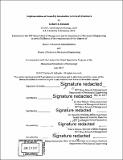| dc.contributor.advisor | Roy Welsch and Daniel E. Whitney. | en_US |
| dc.contributor.author | Eubanks, Zackary R | en_US |
| dc.contributor.other | Leaders for Global Operations Program. | en_US |
| dc.date.accessioned | 2017-09-15T15:35:44Z | |
| dc.date.available | 2017-09-15T15:35:44Z | |
| dc.date.copyright | 2017 | en_US |
| dc.date.issued | 2017 | en_US |
| dc.identifier.uri | http://hdl.handle.net/1721.1/111473 | |
| dc.description | Thesis: M.B.A., Massachusetts Institute of Technology, Sloan School of Management, in conjunction with the Leaders for Global Operations Program at MIT, 2017. | en_US |
| dc.description | Thesis: S.M., Massachusetts Institute of Technology, Department of Mechanical Engineering, in conjunction with the Leaders for Global Operations Program at MIT, 2017. | en_US |
| dc.description | Cataloged from PDF version of thesis. | en_US |
| dc.description | Includes bibliographical references (pages 57-58). | en_US |
| dc.description.abstract | Flexible automation for drilling and countersinking has been successfully implemented in the assembly of a small number of aircraft structures. These systems have demonstrated the capability to reduce the risk of repetitive use injuries, improve quality, and reduce labor costs. Despite these successes, disruptive delays to production resulted when similar technology was initially implemented in the assembly of 777 wing structures. Baseline data was collected to analyze the performance of the system, and it was found that the delays were largely a result of machine breakdowns or error conditions during production. Three changes to the equipment and processes were prioritized because they could be quickly implemented and were expected to address some of the most-common causes of the in-process machine errors. Average drilling times were reduced by 5.9%, and maximum drilling times were reduced by 10% as a result of these changes. Process simulations based on the data demonstrated that the expected frequency of production delays was reduced from 37.4% to 17.6% of all wings produced. | en_US |
| dc.description.statementofresponsibility | by Zackary R. Eubanks. | en_US |
| dc.format.extent | 58 pages | en_US |
| dc.language.iso | eng | en_US |
| dc.publisher | Massachusetts Institute of Technology | en_US |
| dc.rights | MIT theses are protected by copyright. They may be viewed, downloaded, or printed from this source but further reproduction or distribution in any format is prohibited without written permission. | en_US |
| dc.rights.uri | http://dspace.mit.edu/handle/1721.1/7582 | en_US |
| dc.subject | Sloan School of Management. | en_US |
| dc.subject | Mechanical Engineering. | en_US |
| dc.subject | Leaders for Global Operations Program. | en_US |
| dc.title | Implementation of assembly automation in aircraft structures | en_US |
| dc.type | Thesis | en_US |
| dc.description.degree | M.B.A. | en_US |
| dc.description.degree | S.M. | en_US |
| dc.contributor.department | Leaders for Global Operations Program at MIT | en_US |
| dc.contributor.department | Massachusetts Institute of Technology. Department of Mechanical Engineering | |
| dc.contributor.department | Sloan School of Management | |
| dc.identifier.oclc | 1003322003 | en_US |
